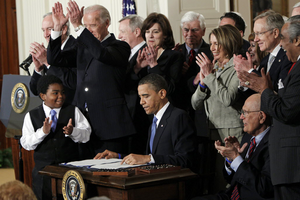Obamacare: 3.3 million enrollees, but surge needed to hit target
The Obama administration called the pace of January enrollments in Obamacare 'encouraging,' but analysts say most who have signed up were previously insured. Six weeks remain to enroll.

President Barack Obama is applauded after signing the Affordable Care Act into law in the East Room of the White House in Washington in 2010.
Charles Dharapak/AP/File
Washington
Nearly 3.3 million Americans have enrolled for health insurance in Obamacare exchanges, and the Obama administration says the pace of January enrollments was “encouraging,” but signups are still running behind pre-launch expectations.
While fewer Americans are now uninsured, health policy analysts say most of those who have enrolled for insurance under the new exchanges are people who used to have some other insurance, not people drawn from the ranks of the uninsured.
With barely six weeks of enrollment left to go, then, the Affordable Care Act (ACA) needs a big surge of signups to avoid falling short of expectations for its rollout year.
Some 1.1 million Americans enrolled for coverage in January, according to a government report on Obamacare. That was down from December’s pace (when enrollment was fueled by people seeking to have coverage begin on Jan. 1) but up from the average pace for the marketplaces’ first three months. For October through December, signups totaled 2.2 million, or a little more than 0.7 million per month.
Health Secretary Kathleen Sebelius emphasized the positives in presenting the new numbers Wednesday.
“More are getting covered,” she said, and a rising share (27 percent in January) were young people whose participation is viewed as crucial to holding down the average cost of insurance for people of all ages. Secretary Sebelius also said that 55 percent of enrollees so far are female, reflecting the law’s efforts to ensure parity of costs across gender lines.
“Being a woman … is no longer a pre-existing condition” that adds to premiums, she told reporters on a conference call.
The Congressional Budget Office, however, had estimated that about 7 million Americans would sign up for 2014 coverage on exchanges, as a mandate that people have insurance or face a tax penalty went into effect.
To hit that level, more people would need to sign up in the final 2 months of enrollment than did so in the first four.
Republican critics of the law pointed to the ongoing challenges with the insurance-exchange launch.
“Under penalty of higher taxes, Americans are mandated by law to have a plan, but they’re still resisting Obamacare,” said Brendan Buck, a spokesman for House Speaker John Boehner. “And many that are actually signing up are only doing so because the law cancelled the plan they had, liked, and could afford.”
The law may be succeeding, meanwhile, at bringing down the number of Americans who lack insurance.
A Gallup poll released Wednesday, separate from the federal report on Obamacare, said that 16 percent of Americans are uninsured today, down from 17 percent in the final quarter of 2013. The poll was conducted between Jan. 2 and Feb. 10, so it doesn’t fully capture all the new enrollees over the past month.
What’s happened, according to the Gallup survey of 19,000 Americans, is that fewer people have employer-sponsored coverage, but that decline has been more than offset by rising enrollment in Medicaid or in plans purchased using the Obamacare exchanges.
This is a bit different from what the CBO had forecast last May. The CBO saw employer-based coverage holding steady, and the number of uninsured dropping more dramatically – to about 14 percent of the population.
It was never an easy task trying to predict how the complex law would affect health insurance across the nation. And at least one big element of the law has changed: The White House opted to delay a mandate on employers to offer coverage to their workers or pay a tax penalty, which had also been set to kick in during 2014.
Many Americans, meanwhile, are enrolling in new insurance on the exchanges because their old insurance plans were cancelled as noncompliant with ACA rules.
Some surveys find that most of the 3.3 million Obamacare enrollments are by formerly insured people, not by the uninsured.
The Obama administration says that’s not all a bad thing.
The Obamacare-compliant policies offer stronger coverage, in many cases, than the old plans did. But for many families, the new plans come with high costs for premiums and copayments.
In some surveys, high costs are a major reason why many Americans have avoided the Obamacare exchanges so far.
It remains to be seen, too, how many enrollees will stick with their decision to become insured. Early trends suggest that perhaps 10 to 20 percent of them won’t end up paying their premiums, writes Bob Laszewski, a consultant to the health insurance industry who is following the enrollment patterns.

